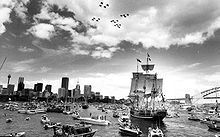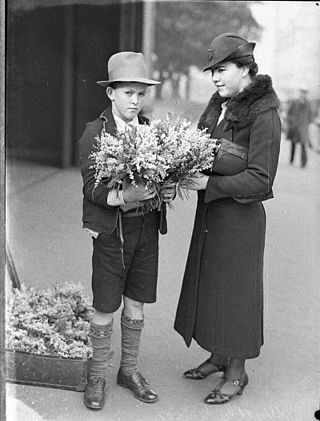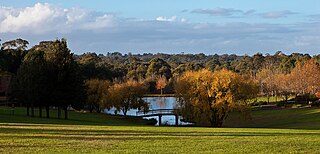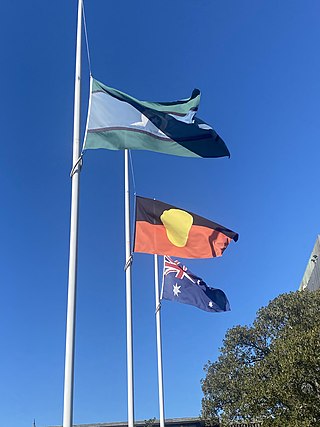
The bicentenary of Australia was celebrated in 1988. It marked 200 years since the arrival of the First Fleet of British convict ships at Sydney in 1788.

The bicentenary of Australia was celebrated in 1988. It marked 200 years since the arrival of the First Fleet of British convict ships at Sydney in 1788.

The bicentennial year marked Captain Arthur Phillip's arrival with the 11 ships of the First Fleet in Sydney Harbour in 1788, and the founding of the city of Sydney and the colony of New South Wales. 1988 is considered the official bicentenary year of the founding of Australia.

The Australian Bicentenary was marked by pomp and ceremony across Australia to mark the anniversary of the arrival of the First Fleet of British ships at Sydney in 1788. [1] The Australian Bicentennial Authority (ABA), pursuant to the Australian Bicentennial Authority Act 1980, [2] was set up to plan, fund and coordinate projects that emphasized the nation's cultural heritage. State councils were also created to ensure cooperation between the federal and state governments. The result was a national programme of events and celebrations to commemorate the Bicentenary, including:
The opening ceremony of the 16th World Scout Jamboree, which took place at midnight on 31 December 1987, was the first official event of Australia's Bicentenary.
In collaboration with state governments, the Commonwealth/State Bicentennial Commemorative Program was established with the development of Heritage Trails in each state. [3]
On Australia Day, Sydney Harbour hosted a re-enactment of the arrival of the First Fleet. The Hawke government refused to fund the First Fleet re-enactment, because it believed this might offend Indigenous Australians. [4] Radio 2GB in Sydney stepped in and held a fund raising appeal to keep the re-enactment on track. The government instead funded a rival display of Tall Ships which sailed up Australia's east coast and entered Sydney Harbour on the day, and it was felt that this was more acceptable to the Indigenous community.
Australia's floral emblem was officially declared to be the Golden Wattle Acacia pycnantha. The Gazettal was signed by the Governor General, Sir Ninian Stephen, on 19 August 1988. A ceremony was held on 1 September 1988 at the Australian National Botanic Gardens. The Minister for Home Affairs, Robert Ray, made the formal announcement and the Prime Minister's wife, Mrs Hazel Hawke, planted a Golden Wattle. [5]

1988 was also marked by the completion of many unique development projects such as the Bicentennial National Trail and on 9 May of that year, Queen Elizabeth II opened the New Parliament House in Canberra. [6] As well as this, the modern Darling Harbour precinct was completed and opened, as was the modern Sydney Football Stadium. It was also marked by the creation of one of Australia's most significant art works, the Aboriginal Memorial , which commemorated those Indigenous Australians who died as a result of European settlement. [7] Other events included the Bicentennial Beacons, a series of bonfires lit around Australia. A celebration featuring motor cycle riders from around Australia was also held in Canberra during the year. Not all events went well with the disastrous Round Australia Yacht Race claiming several lives and being the subject of legal action.
A new musical Manning Clark's History of Australia , directed by John Bell, that was loosely based on the life of historian Manning Clark opened in January at Princess Theatre (Melbourne) to coincide with the Bicentenary, but facing poor reviews and concomitant lack of attendance, closed before the end of February.
Significant improvements to Australian roads were made through the Australian Bicentennial Road Development Program. [8]
The Australian Army formed the Tattoo Regiment in June that was made up of sub-units from the Army's 1st Brigade, including 3 RAR, 5/7 RAR, 2 Cav Regt, 8/12 Medium Regiment and others. It was named Army Tattoo 88 and toured Sydney, Brisbane, Townsville, Darwin, Perth, Adelaide, Hobart, Melbourne and Canberra (although cancelled due to weather). It also had military bands the UK, US, Canada, PNG and New Zealand. The theme was the 200 years of military history in Australia
The event triggered debate on Australian national identity, Indigenous rights, historical interpretation and multiculturalism.
The event was widely viewed as controversial. [9] Planning for the event raised issues of national identity and historical interpretation. [10] Some wanted to remember the colonisation as an invasion, while others wanted it to focus on historical re-enactments. The Uniting Church in Australia wanted people to boycott the event unless Aboriginal rights were recognised. Anglican Church of Australia bishop George Hearn described the celebrations as an "historical absurdity" for its ignorance of 40,000 years of Aboriginal life and culture. [11] The official slogan was "Living Together" which emphasised the theme of multi-culturism. Former Prime Minister Malcolm Fraser had intervened to change the motto to "The Australian Achievement" in order to be more celebratory. Bob Hawke later restored the original motto. The response from the right wing in the country was loud. The Institute of Public Affairs suggested that tradition had been sacrificed to appease a minority. The historian Geoffrey Blainey claimed the Bicentenary was attempting to re-write the British out of the history of Australia. [10]
The protest was planned immediately after the 1982 Commonwealth Games protests. [12] On 26 January 1988, more than 40,000 people, including Indigenous Australians from across the country, staged the largest march in Sydney since the early 1970s Vietnam Moratorium demonstrations. The protesters marched through Sydney chanting for land rights. The march ended at Hyde Park, where several prominent Aboriginal leaders and activists spoke, among them Gary Foley. [13] Dubbed the Long March for Justice, Freedom and Hope, [14] or just March for Justice, Freedom and Hope, Linda Burney was one of the organisers. [15] ) Lyall Munro Jnr also participated in the protests. [16] The march was featured in an episode of the 2013 documentary TV series, Desperate Measures . [15]
Demonstrations were also held in other cities and towns, including Canberra. This was part of a wider Bicentennial Boycott movement, which started in the lead-up to the Bicentennial.[ citation needed ]

The First Fleet was a fleet of 11 British ships that took the first British colonists and convicts to Australia. It comprised two Royal Navy vessels, three store ships and six convict transports. On 13 May 1787 the fleet under the command of Captain Arthur Phillip, with over 1400 people, left from Portsmouth, England and took a journey of over 24,000 kilometres (15,000 mi) and over 250 days to eventually arrive in Botany Bay, New South Wales, where a penal colony would become the first British settlement in Australia from 20 January 1788.

The Aboriginal Tent Embassy is a permanent protest occupation site as a focus for representing the political rights of Aboriginal Australians and Torres Strait Islander people. Established on 26 January 1972, and celebrating its 50th anniversary in 2022, it is the longest continuous protest for Indigenous land rights in the world.

Gary Edward Foley is an Aboriginal Australian activist of the Gumbaynggirr people, academic, writer and actor. He is best known for his role in establishing the Aboriginal Tent Embassy in Canberra in 1972 and for establishing an Aboriginal Legal Service in Redfern in the 1970s. He also co-wrote and acted in the first Indigenous Australian stage production, Basically Black.
The following lists events that happened during the year 1988 in Australia.

The Day of Mourning was a protest held by Aboriginal Australians on 26 January 1938, the 150th anniversary of the arrival of the First Fleet, which marked the beginning of the colonisation of Australia. It was declared to be a protest of 150 years of callous treatment and purposefully coincided with Australia Day celebrations. Day of Mourning protests have been held on Australia Day ever since 1938, though protests sharing its aims on this day are more commonly held under the names Invasion Day or Survival Day.
Kevin John Gilbert was an Aboriginal Australian author, activist, artist, poet, playwright and printmaker. A Wiradjuri man, Gilbert was born on the banks of the Lachlan River in New South Wales. Gilbert was the first Aboriginal playwright and printmaker. He was an active human rights defender and was involved in the establishment of the Aboriginal Tent Embassy in 1972 as well as various protests to advocate for Aboriginal Australian sovereignty.

Royal tours of Australia by the British royal family have been taking place since 1867. Since then, there have been over fifty visits by a member of the Royal Family, though only six of those came before 1954. Elizabeth II is the only reigning monarch of Australia to have set foot on Australian soil; she first did so on 3 February 1954, when she was 27 years old. During her sixteen journeys, the Queen visited every Australian state and the two major territories.

Wattle Day is a day of celebration in Australia on the first day of September each year, which is the official start of the Australian spring. This is the time when many Acacia species, are in flower. So, people wear a sprig of the flowers and leaves to celebrate the day.

Tradewind is a Dutch topsail schooner. She was built in the Netherlands in 1911 as a herring lugger named Sophie Theresia.

Ellen José (1951 – 2 June 2017) was an Australian Indigenous artist, photographer and anarchist. She was a Torres Strait Islander descendant from Murray, Darnley and Horn Islands who lived in Melbourne with husband and fellow anarchist Joseph Toscano.

Australia Day is the official national day of Australia. Observed annually on 26 January, it marks the 1788 landing of the First Fleet and raising of the Union Flag of Great Britain by Arthur Phillip at Sydney Cove, a small bay on the southern shore of Sydney Harbour. In present-day Australia, the government Australia Day Council organises events that seeks to recognise the contributions of Australians to the nation, while also encouraging reflection on past wrongs including towards Indigenous Australians and also giving respect and celebrating the diversity and achievements of Australian society past and present. The presentation of community awards and citizenship ceremonies are also commonly held on the day. The holiday is marked by the presentation of the Australian of the Year Awards on Australia Day Eve, announcement of the Australia Day Honours list and addresses from the governor-general and prime minister. It is an official public holiday in every state and territory. With community festivals, concerts and citizenship ceremonies, the day is celebrated in large and small communities and cities around the nation. Australia Day has become the biggest annual civic event in Australia.
Aus Steam '88 was an Australian Bicentenary activity in Melbourne, Australia featuring many steam locomotives from New South Wales, Victoria and also England. The event took place at Spencer Street station from 15 to 29 October, and also included tours on Victorian rail lines involving the participating locomotives.

The Aboriginal Memorial is a work of contemporary Indigenous Australian art from the late 1980s, and comprises 200 decorated hollow log coffins. It was conceived by Djon (John) Mundine in 1987–88 and realised by 43 artists from Ramingining and neighbouring communities of Central Arnhem Land, in the Northern Territory. Artists who participated in its creation included David Malangi and George Milpurrurru.
George Arthur Hearn was the ninth Anglican Bishop of Rockhampton from 1981 until 1996.

The First Fleet Reenactment Voyage was a project to assemble a fleet of tall ships to sail from England to Australia in a historical reenactment of the First Fleet that colonised Australia in 1788. The reenactment was first conceived in 1977 and organised to commemorate Australia's bicentenary of colonisation. Despite opposition and minimal funding from the Australian government, the project attracted the support of high-profile adventurers Thor Heyerdahl, Alan Villiers, and Sir Edmund Hillary, as well as former Australian political figures and the British Royal Family. Several corporations offered to sponsor the fleet as a whole or individual ships, and additional money was raised by selling "training crew" berths for the various legs of the voyage.

The Australian Hall is a heritage-listed community building located at 150–152 Elizabeth Street, in the Sydney central business district, in the City of Sydney local government area of New South Wales, Australia. It was the site of the Day of Mourning protests by Aboriginal Australians on 26 January 1938. It was also known as the Cyprus–Hellene Club until 1998. The property is owned by the Indigenous Land Corporation, a statutory corporation of the Australian Government. It was added to the Australian National Heritage List on 20 May 2008 and was added to the New South Wales State Heritage Register on 2 April 1999.

Fagan Park is a large recreational area located in Galston, a semi-rural area in Sydney, New South Wales, Australia. The park has been managed by Hornsby Shire since its opening in 1988, and covers an area of 55 hectares. The land that is now the park was home to the Fagan family until 1980, when Bruce Fagan and his sister, Ida, donated the land to the New South Wales State Government. Hornsby Shire Council was appointed sole trustee. The park was officially opened by the Premier of New South Wales, Nick Greiner, MP on 5 November 1988.

Redfern Park is a heritage-listed park at Elizabeth, Redfern, Chalmers and Phillip streets, Redfern, Sydney, Australia. It was designed by Charles O'Neill. It was added to the New South Wales State Heritage Register on 21 September 2018.

Reconciliation in Australia is a process which officially began in 1991, focused on the improvement of relations between the Aboriginal and Torres Strait Islander peoples of Australia and the rest of the population. The Council for Aboriginal Reconciliation (CAR), created by the government for a term of ten years, laid the foundations for the process, and created the peak body for implementation of reconciliation as a government policy, Reconciliation Australia, in 2001.

Australia Day has been a national public holiday date since 26 January 1994, on the anniversary of Captain Arthur Phillip’s First Fleet raising the British Union Jack flag at Sydney Cove in 1788. After the Federation of Australia on 1 January 1901, the official recognition and dates of Australia Day and its corresponding holidays emerged gradually and changed many times. Further alternations and alternatives have been proposed for debate, but not yet officially agreed or adopted.
Saturday, 12 August 2016, Moree, New South Wales.